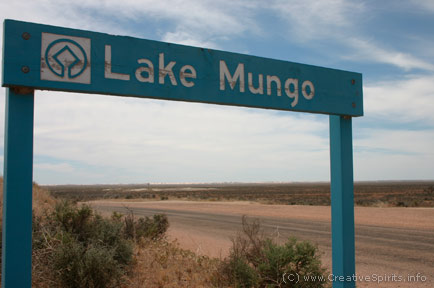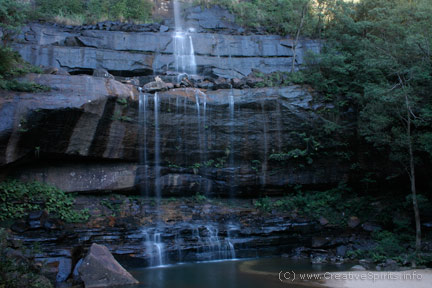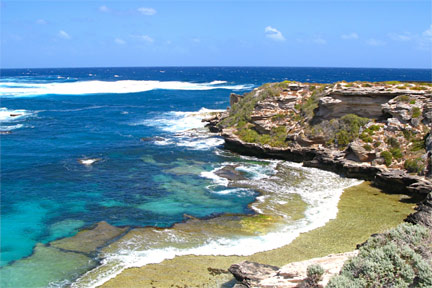History
Timeline results for 3000 to 500000
Found 50 results for your search. Showing page 1 of 3.
Year from 3000, year to 500000
400,000
-
Mitochondrial DNA puts the origin of Homo Sapiens much further back and indicates that Australian Aboriginal people arose 400,000 years ago from two distinct lineages, far earlier than any other racial group. [1]
120,000
-
Analysis of pollen and charcoal giving a date of 120,000 BP suggests that people were using fire to clear land in the Lake George basin in the Southern Tablelands of NSW, about 30 kms north-east of Canberra. [2] Experts also found signs of human disturbance in rainforest pollen patterns in a drill core from the edge of the continental shelf, 80 kilometres east of Cairns.
Similarly, research presented to the Royal Society of Victoria in 2019 by a group of academics found that blackened stones at Moyjil (Point Ritchie, Victoria), were between 100,000 and 130,000 years old. While cautious, the authors concluded that human habitation was the most likely explanation for "marine shells, stones in unexplained depositional context and fire resemblance to hearth". [3]
80,000
-
Possible age of artefacts found at the Madjedbebe rock shelter, Kakadu National Park (NT) in 2017 [4].
73,000
-
Upper range for the age of teeth found at Lida Ajer cave in the Padang Highlands of Sumatra, Indonesia, supporting the dominant theory that Homo sapiens migrated from Africa around 100,000 years ago and then spread through Asia, reaching also Australia. [5]
72,000
-
Aboriginal and Papuan ancestors leave Africa, reaching the supercontinent of 'Sahul' that originally united Tasmania, Australia and New Guinea around 50,000 years ago.[6]
68,000
-
Estimated time of the arrival of Aboriginal people in Australia in 2008 [7].
65,000
-
Age of an axe-grinding stone found at Aboriginal campsite Madjedbebe, within the Jabiluka uranium mining lease in Kakadu National Park, NT. The stone is considered to be the oldest confirmed evidence of the occupation of Australia (at the time of discovery in 2017), estimated to be 65,000 years old, 18,000 years older than previous evidence, thus "rewriting the history of Australia". [8]
-
A study, published in the Quaternary Science Reviews, estimates migration to the bridge of islands off north-west Australia occurred between about 50,000 and 65,000 years ago when the sea was 75 metres lower and the islands visible. Using wind and ocean current modelling, the experts also show that Aboriginal settlement is a result of large-scale migration by skilled maritime explorers and no accident. [9]
56,000
-
Archaeological evidence suggests that a rock shelter was used by people at a site in Arnhem Land (400 kms east of Darwin) in the Northern Territory. They used stone tools and red ochre probably to prepare pigments for rock painting or body decoration.
-
Suggested age of two north Australian sites (Nauwalabila and Malakunanja, about 300 kms east of Darwin).
50,000
-
A study of ancient Aboriginal hair samples reveals distinct Aboriginal populations were present in Australia with little geographical movement for up to 50,000 years. The research found that Aboriginal people are the descendants of a single founding population that arrived in Australia 50,000 years ago, while Australia was still connected to New Guinea. Populations then spread rapidly – within 1,500 to 2,000 years – around the east and west coasts, meeting somewhere in South Australia. [10]
Clearly the environment did change significantly but nevertheless they were able to survive in one area with a fixed set of resources for up to 50,000 years. Nowhere else in world have humans been able to demonstrate an ability to do that.
— Prof Alan Cooper, research project leader [10]
49,000
-
Archaeologists find the earliest known use of ochre in Australia and south-east Asia and bone fragments of extinct megafauna, including the diprotodon, at the Warratyi rock shelter in the northern Flinders Ranges, SA, in the traditional lands of the Adnyamathanha people. “The idea there was no interaction between humans and megafauna has really been put to bed by the Warratyi evidence.” [11]
45,000
-
Rock engravings made in South Australia - the earliest dated petroglyphs.
-
Research by the Australian National University suggests the most likely route taken by the first people to come to Australia was from southeast Asia to the Australian mainland. It identifies the least-cost route as going from Borneo to Sulawesi and through a series of smaller islands to Misool Island off the coast of West Papua. It follows roughly the same path as the northern route described by US anthropologist Joseph Birdsell in 1977. Proof for that route is still lacking because the islands along Birdsell’s northern route have received comparatively little archaeological attention due to isolation, expense, and political conflict in West Papua." [12]
43,000
-
Age of ‘Mungo Man’ (also known as Lake Mungo 3 human remains, or LM3), a hunter gatherer who lived in western NSW. His skeleton is the oldest known remains in Australia. Named after Lake Mungo National Park, NSW, 987 km west of Sydney, where his remains were found. Footprints discovered at Lake Mungo are believed to be 23,000 years old.

Lake Mungo, New South Wales. Ancient camp sites have been found in this area. -
The oldest dated art in Europe is 40,800 years old and was found in the El Castillo cave in Spain. It contains many red hand stencils, similar to stencils found in Australia.
37,000
-
Papuan and Aboriginal groups split, long before the continents are finally cut off from each other (around 8,000 years ago).[6]
35,000
-
Age of a oldest known camping site found in the Pilbara region, Western Australia, near the Jugaling Rock Shelter. The site belongs to a mining lease jointly owned by Rio Tinto and Hancock Prospecting. Both companies refuse to permanently exclude the site from mining [13].
-
Carved tools discovered in Riwi Cave in the southern Kimberley region of Western Australia are thought to be between 35,000 and 46,000 years old which would make them the oldest artifacts of their type found in Australia. Archaeologists excavated eight tools made from kangaroo bone in the early 1990s. They might have been used as spear tips or for weaving baskets or working skins.
30,700
-
Aboriginal people living at the Keilor site (20 kms north-west of Melbourne) in Victoria.
-
Age of fireplaces (such as underground oven) at Lake Mungo National Park, NSW.
30,000
-
Devils’ Lair in southernmost Western Australia is home to Aboriginal people who leave bone tool artefacts, including unique bone-beads of split-pointed macropod shin bones. The cave is occupied from this time to 6,000 BP.
-
Aboriginal people were living around the now extinct lakes of the Willandra Lakes system. Evidence shows signs of spiritual and creative life and technology linked to much later Aboriginal culture.
-
A man from the Lake Mungo area (south-west NSW) is buried in a shallow grave. His forearm bones are stained pink from ochre. This is one of the earliest known burials of a distinctly modern people.
-
Oldest evidence of bread making in the world at Cuddy Springs (ancient lake located between Marra Creek and Macquarie River, near Carinda, western NSW).
28,000
-
Age of a charcoal drawing found at Narwala Gabarnmung, in the Northern Territory, assumed to be Australia’s oldest known rock art specimen and one of the earliest examples of human art on the planet [14]. The art was only found in 2012. Because it was made with charcoal, radiocarbon dating could be used to determine its age with a higher degree of confidence.
26,000
-
The body of a woman from Lake Mungo provides the earliest evidence in the world of ritual cremation. The body is prepared with ochre before cremation.
-
Age of bones found in sediment at the Willandra Lakes Region of far western NSW.
22,000
-
Age of a rock-shelter on the Kings Tableland near Wentworth Falls, NSW.

Wentworth Falls, New South Wales. An occupation site has been found in this area dated 22,000 years old. -
Aboriginal people living at Malangangarr in Arnhem Land, Northern Territory, use ground-edge grooved axes. Australian technology leads the world.
-
In deep caves under the Nullarbor Plains at Koonalda (at the western edge of South Australia, about 50 kms from the ocean), Aboriginal people mine flint and leave grooved designs on the cave walls. This is early evidence of the close relationship of art and work in Aboriginal life.
20,000
-
Some 10% of Tasmania is covered by glacial ice. Kutikina Cave on the Franklin River is occupied by Tasmanian Aboriginal people at the height of the last ice age.
-
Aboriginal people were dispersed across the entire continent, occupying places as remote as rock shelters on the Franklin River in south-west Tasmania and at Birrigai in the ranges of the Australian Capital Territory, which surrounds Canberra, the national capital.
-
Rising seas partially submerge Sahul, the landmass that connects Australia, New Guinea and Tasmania, creating separate islands for each.
18,000
-
Art at Ubirr in Kakadu National Park (Northern Territory, 300 kms east of Darwin) depicts now extinct animals, the Thylacine (Tasmanian tiger), and Zaglossus (the long-beaked echidna).
-
Harvesting grass seeds is integral to Aboriginal socio-economic life on the large grasslands. The seeds were ground and baked or roasted and eaten whole.
17,300
-
Scientists confirmed that a painting of a kangaroo in a sandstone rock shelter near the Drysdale River, in Western Australia’s remote Kimberley region, is about 17,300 years old, making it the oldest known rock art in Australia.
16,000
-
Sea levels begin to rise as ice caps melt. Inland lakes such as Lake Mungo have dried up.
-
Hearths, stone and bone tools, Shaws Creek near Yarramundi (60 kms north-west from Sydney), NSW.
13,000
-
At Kow Swamp near Cohuna, 230 kms north of Melbourne, Victoria, Aboriginal people weare kangaroo teeth headbands similar to those worn by men and women in the Central Desert in the 19th century.
-
Land bridges between mainland Australia and Tasmania are flooded. Tasmanian Aboriginal people become isolated for the next 12,000 - 13,000 years.
10,000
-
Aboriginal people at Wyrie Swamp near Millicent, 340 kms south-east of Adelaide, South Australia, use returning boomerangs to hunt waterfowl.
-
Present day Australian climate establishes.
8,000
-
Earliest visible evidence of Aboriginal belief connected with the rainbow Serpent. This becomes the longest continuing belief in the world.
-
The Torres Strait Islands are formed when the land bridge between Australia and New Guinea is submerged by rising seas.
5,000
-
Coastline of Australia takes its present form. Rottnest Island (off Perth, WA), previously connected to mainland Australia, becomes an island.

Rottnest Island, Western Australia. Aboriginal people saw the island when it was still connected to the mainland. Photo: Zsuzsanna Kilian, sxc.hu -
Settlement of Pacific Islands.
-
Occupation site, Penrith Lakes (about 50 kms west of Sydney), NSW.
4,000
-
Research indicates that humans migrated to Australia from India [15], bringing with them different tool-making techniques such as microliths (small stone tools that formed the tips of weapons), and the Dingo, which most closely resembles Indian dogs.
125
-
Archaeologists in 2020 found ancient banana farms on Mabuyag Island, once managed by Torres Strait Islanders, dating back 2,145 years. They unearthed banana microfossils, stone tools, charcoal and a series of retaining walls. The findings strengthen the theory that the Islanders engaged in complex and diverse cultivation and horticultural practices. [16]
References
View article sources (16)
[1]
'Homo sapien sapiens originated in Australia, not ‘out-of-Africa’ – DNA evidence', The Stringer 18/12/2013
[2]
'A history and interpretation of fire frequency in dry eucalypt forests and woodlands of Eastern Tasmania', J. von Platen, PhD thesis, University of Tasmania, 2008 p.15, http://eprints.utas.edu.au/7812/
[3]
''A big jump': People might have lived in Australia twice as long as we thought', The Guardian 11/3/2019
[4]
'Australian dig finds evidence of Aboriginal habitation up to 80,000 years ago', The Guardian Australia, 20/7/2017
[5]
''We've found the missing 20,000 years': crucial piece in human migration puzzle', SMH 20/8/2017
[6]
[6a]
'World-first genome study reveals rich history of Aboriginal Australians', ABC News 22/9/2016
[7]
'Owners fight to protect country', Koori Mail 424 p.10
[8]
'Australia's oldest human technology emerges from 65,000 hidden years', SMH 20/7/2017
[9]
'Aboriginal settlement in Australia was planned migration: study', SMH 21/5/2018
[10]
[10a]
'Aboriginal DNA study reveals 50,000-year story of sacred ties to land', The Guardian 9/3/2017
[11]
'Astounding archaeology discovery places inland human occupation of Australia at 49,000 years', SMH 3/11/2016
[12]
'First humans to reach Australia likely island-hopped to New Guinea then walked – study', The Guardian 31/10/2018
[13]
'Owners fight to protect country', Koori Mail 424 p.10
[14]
'Kiwi finds 28,000 year old painting', The New Zealand Herald, 19/6/2012
[15]
'Genomes link aboriginal Australians to Indians', nature.com 14/1/2013. Some Aboriginal Australians can trace as much as 11% of their genomes to India.
[16]
'Indigenous Australians 'farmed bananas 2,000 years ago'', BBC News 12/8/2020


